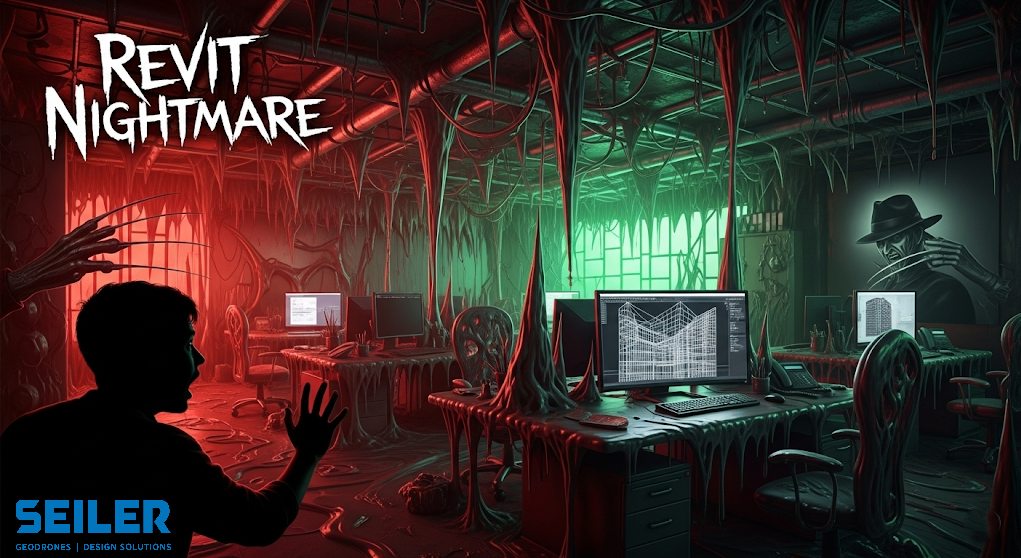😱Alright, buckle up horror flix fanatics! You’re diving into the wonderful world of Autodesk Revit for your next big Architecture, Engineering, or Construction (AEC) project. That’s fantastic! But before you start modeling every nook and cranny, let’s talk about something crucial for teamwork and sanity: Worksets. “Spooky”😱
Think of worksets as the different dream layers in Nightmare on Elm Street. Without them, your entire project becomes one giant, chaotic dreamscape where everyone is bumping into each other, deleting walls by accident, and generally causing more terror than Freddy on a Friday night.
But fear not, my brave designers! Setting up worksets doesn’t have to be a nightmare. Follow these steps, and you’ll be navigating your Revit project like Nancy Thompson dodging booby traps.

Step 1: Enabling Worksharing – Waking Up from the Individual Dream 🛌
First things first, you need to “wake up” your project and enable worksharing. This is like realizing you’re in a dream and deciding to take control (sort of!).
- Save Your Central Model: Make sure your project is saved. This will become your central model, the main dream from which all local models (your individual working copies) will be created.
- Collaborate Tab is Your Ally: Head over to the Collaborate tab in Revit. It’s like finding Nancy’s stash of weapons – essential for survival!
- Click “Collaborate”: In the Manage Collaboration panel, click the big “Collaborate” button.
- Choose Your Battlefield: You’ll be asked how you want to collaborate. For most office environments, “Within your network” is the way to go. Think of it as keeping the nightmare localized to Springwood. Click “OK”.
- Save Again (The Central Model): Revit will prompt you to save your central model again. Do it! This finalizes the switch to a workshared environment. You’ll notice some new options popping up – these are your dream control buttons!
Now you’re officially in a workshared project. Time to carve out your individual dream spaces!
Step 2: Creating Your Worksets – Defining Your Dream Layers 🗺️
This is where the real magic (or sanity-saving, in our case) happens. You’ll define the different worksets, essentially dividing the project into manageable chunks. Think of these as the different rooms in a dream house or the distinct fears Freddy exploits in each victim.
- The Worksets Dialog Box: In the Collaborate tab, within the Manage Collaboration panel, click “Worksets”. This opens the Worksets dialog box – your control panel for the dream layers.
- Default Worksets: Revit automatically creates two worksets: “Shared Levels and Grids” (the fundamental structure of the dream) and “Workset1” (a generic starting point). You can rename “Workset1” to something more descriptive right away by selecting it and clicking “Rename”.
- Creating New Worksets: Click the “New…” button. In the New Workset dialog, give your workset a descriptive “Name”. Consider these categories:
- By Discipline: If you have separate architecture, structural, and MEP teams, create worksets like “Architecture,” “Structural,” and “MEP.” This keeps the different nightmares (design aspects) separate.
- By Building Area/Floor: For larger projects, you might have worksets like “Level 1,” “Level 2,” “Tower Core,” “East Wing,” etc. This is like having different locations within the dream world.
- By System: For MEP, you could have “HVAC,” “Plumbing,” “Electrical.” For structural, “Framing,” “Foundations.” These are the specific monsters lurking in the dream.
- Entourage/Site: Elements like furniture, planting, and site elements can often be placed on their own worksets. These are the less scary parts of the dream… usually.
- Visibility: The “Visible in all views” checkbox determines if elements on that workset are visible by default in new views. You can always override this in individual view properties, but setting it appropriately here saves time.
- Owner (Optional): You can assign an “Owner” to a workset. This is more of a suggestion than a strict lock, but it can help teams understand who is primarily responsible for elements on that workset. Think of it as knowing who is currently being chased by Freddy in that particular dream sequence.
- Repeat: Keep clicking “New…” and defining worksets until you’ve covered the major divisions of your project. Be thoughtful – you don’t want too few (everyone tripping over each other) or too many (managing them becomes a nightmare in itself!).
- Click “OK”: Once you’ve created all your necessary worksets, click “OK” to close the Worksets dialog.
Now your project is divided into distinct dream layers! Each team member or area of focus has their own space to work without constantly interfering with others.
Step 3: Making Worksets Editable – Claiming Your Dream Space 🛌✍️
Just because you’ve created worksets doesn’t mean you automatically own everything within them. You need to make the worksets (or elements within them) editable to make changes. This is like Nancy setting a trap and claiming that part of the dream as her own.
- Worksharing Monitor (Your Dream Alarm Clock): It’s a good idea to have the Worksharing Monitor open. You can find it in the Collaborate tab, Monitor panel. This palette will show you the status of worksets and elements – who owns what, and if anything needs to be synchronized.
- Making Worksets Editable: There are a few ways to do this:
- “Editable Only” Mode (Stealth Mode): In the Worksharing Monitor or the Worksets dialog, you can set your workset display to “Editable Only”. This visually highlights the worksets you currently have permission to modify.
- Right-Clicking Elements: If you select an element that belongs to a workset you don’t own, you’ll see an option in the right-click menu: “Make Worksets Editable”. Clicking this will request ownership of the element’s workset.
- Borrowing Elements: If you only need to make a small change to an element on a workset someone else owns, you can “borrow” it. When you try to edit it, Revit will usually prompt you to make that element (and potentially its workset) editable.
- Relinquishing Elements/Worksets (Letting Go of the Dream): Once you’re done working on elements or worksets, it’s good practice to relinquish them. This allows other team members to make changes. You can do this in the Collaborate tab, Relinquish panel. You can choose to relinquish all elements or specifically selected ones. It’s like Nancy letting go of a trap after Freddy has been dealt with (for now).
Step 4: Synchronizing with Central – Waking Up Together (Mostly) ⏰
Regularly synchronizing with the central model is crucial. This is how everyone’s individual dream layers merge and everyone sees the collective progress (and hopefully not too many Freddy-esque surprises).
- The “Synchronize with Central” Button: In the Collaborate tab, click “Synchronize with Central”. It looks like two chasing arrows – fitting, right?
- Review Your Changes: Before synchronizing, you can review the elements you’ve modified.
- Add Comments: It’s good practice to add comments describing the changes you’ve made. This helps the team understand what’s been updated.
- Click “OK”: Revit will save your local model and then update it with the changes from the central model. It will also push your changes to the central model. This is like everyone in Springwood briefly waking up and realizing what happened in their individual nightmares.
- Do it Often! Just like you wouldn’t want to stay trapped in a nightmare for too long, you don’t want to go too long without synchronizing. Aim for every 15-30 minutes, or whenever you’ve made significant changes.
Step 5: Local Files – Your Personal Dream Journal 📓
Remember that when you’re working in a workshared environment, you’re always working in a local file. This is a copy of the central model on your computer.
- Creating a New Local: Every time you start working on the project, always create a new local file. Do not work directly in the central model! Think of your local file as your personal dream journal where you record your experiences in the dream. Creating a new one each time ensures you have the latest version of the central model and prevents corruption. To create a new local, go to File > Open, select the central model, and make sure “Create New Local” is checked before clicking “Open”.

Avoiding the Revit Nightmares (Worksharing Edition) 😨
By following these steps and understanding the principles of worksharing, you’ll significantly reduce the chances of encountering project-killing nightmares:
- Communication is Key: Just like the kids in the movie need to communicate about their dreams, your team needs to communicate about workset ownership and changes.
- Be Mindful of Ownership: Don’t go around trying to edit elements on worksets you don’t own without a good reason. It’s like barging into someone else’s nightmare!
- Synchronize Regularly: We can’t stress this enough! It keeps everyone on the same page and prevents major conflicts.
- Save Your Local File Frequently: You don’t want to lose your work if your computer crashes – that’s a real-world nightmare!
So there you have it! Setting up and managing worksets in Revit might seem a little daunting at first, but it’s a crucial skill for any collaborative AEC project. By thinking of it like navigating the dream layers of Nightmare on Elm Street, hopefully, it becomes a little more engaging (and less terrifying!). Now go forth, create your worksets, and build amazing things without getting caught in a Freddy-esque Revit disaster! Sweet dreams… and happy modeling! 🛌✨


Leave A Comment